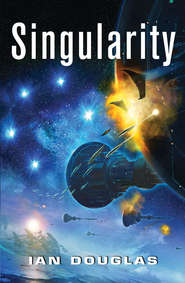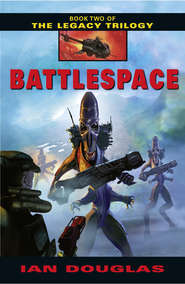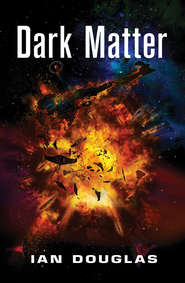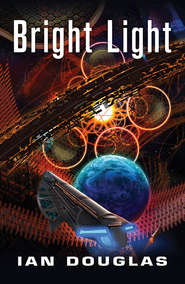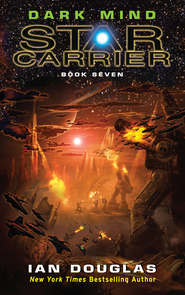По всем вопросам обращайтесь на: info@litportal.ru
(©) 2003-2024.
✖
The Star Carrier Series Books 1-3: Earth Strike, Centre of Gravity, Singularity
Настройки чтения
Размер шрифта
Высота строк
Поля
Mohammed Baqr, Ostend knew, was a xenobiologist, one of the senior scientists in the Mufrid colony on Haris, so he must know what he was talking about. It sounded crazy, though—plants moving and swarming like hungry piranhas.
“Can they get through his suit?”
“Eventually. Swarmers possess grinding plates within their ventral orifices, very hard, like organic diamond. The carbon nanoweave fiber of our e-suits is extremely tough, but eventually the grinding will wear through, yes. We’ve lost several of our people to the swarms.”
The two corpsmen were unfolding a collapsible stretcher and were strapping the pilot onto it. Swarmers continued to flit through the shadows, circling, moving closer.
“Those things can’t be plants.”
“The analogy is inexact,” Baqr told him. “Remember, this is an alien world, with an alien biosphere. We use words like “plant” and “animal” because these are the only words we have, and they come with meanings shaped by our experiences on Earth. The reality is … different. Much different.”
“Yeah, but look at them! Those things are tracking our people!”
“Technically, the individual swarmers all are part of a single organism. It … disperses itself across hundreds of square kilometers in order to locate widely scattered deposits of accessible minerals. When one … leaf finds a source of easily ingested carbon, we believe it communicates with the others through low-frequency sound waves transmitted through this dense atmosphere. And they begin to swarm. More and more of them, drawn from farther and farther away.”
“So we’re dealing with walking, meat-eating trees,” Ostend said.
“Ah … no. The swarmers are not plants, really.”
“Then they’re animals that act like plants … except they eat meat and move?”
“They are neither plants nor animals,” Baqr said, a touch of exasperation edging his voice, “not in the sense you mean.”
Ostend was about to reply to that, but he saw that the two corpsmen were approaching the hopper, carrying the stretcher between them. So far as he was concerned, the Marines would be getting off of this rock soon and he wouldn’t have to worry about swarmers, whatever the hell they truly were, ever again.
“How’s the patient?” he called over the comm net.
“Alive, Lieutenant,” was McMillan’s response. “But that’s about all. Cargo deck hatch is closed and sealed.”
“Here’s some fresh air, then,” Ostend said, passing his hand through a virtual control. “Don’t try breathing it yet, though.” Pure nitrogen began flowing into the pressure-tight cargo deck, forcing out the native atmosphere—nitrogen because the higher oxygen content of a terrestrial atmosphere might react unpleasantly with the methane and other compounds in the Haris gas mix. He brought the cargo deck pressure up to two and a half atmospheres, then began bleeding off the overpressure and adjusting the gas mix to Earth standard.
By that time, the hopper had lifted from that desolate, scorched-rock plain and was streaking north, back toward the Marine perimeter.
To Ostend’s way of thinking, in fact, they couldn’t leave Haris soon enough. The collie they’d assigned as his friendly native guide could have the place and its weird biology.
Blue Omega One
VFA-44 Dragonfires
Battlespace Eta Boötis IV
0022 hours, TFT
“Form on me, Blue Omegas,” Allyn called. “Staggered right echelon. Make it count!”
The Dragonfires, what was left of them, were well into the merge, hurtling through the rear zone of the Turusch fleet. Enemy vessels were pinging her Starhawk’s sensors from every side now. A brilliant flash close aboard marked the detonation of an enemy nuke striking a sandfield.
She knew she was rewriting the book on gravfighter tactics. The question was whether she’d be around later to autograph copies.
Five ships, the tattered remnant of Blue Omega, had continued to close with the Turusch battlefleet. Moments before, dozens of Starhawk fighters—the other strike squadrons off the America—had merged with the enemy ships dead ahead, then passed through, leaving a trail of silent, blossoming explosions in their wake. Decelerating swiftly, the other Starhawks had swarmed past the oncoming Blue Omega fighters, heading back toward the planet, slowed to a halt, then begun accelerating back the other way, slowly coming up behind the five Dragonfires.
Blue Omega continued to accelerate, approaching the enemy fleet from behind, well in the lead of the rest of America’s gravfighters.
She was angling toward one Turusch ship in particular, a gigantic target identifiable only by its enormous mass. The thing was almost certainly a PC—a planetoid converted to a command ship, with a mass registering in the billions of tons and a shield signature five kilometers long. Allyn couldn’t see the ship itself. It was still a long way off, almost two thousand kilometers, and its shields were so hard-driven by Confederation fire right now that they were almost constantly up, rendering the flying mountain all but invisible. As she neared it, though, she could see the strobing pulse and flash of Confederation warheads detonating against those shields, a steady, flickering, coruscating volley as incoming beams, nuclear warheads, and KK projectiles were twisted back by the Turusch gravitic shields in raw sprays of radiation.
And the Blue Omegas were dropping straight into the heart of that pyrotechnic hell.
Allyn checked course, velocity, and rate of closure once again. The idea was to skim past as close to the enemy shields as possible without becoming part of that ongoing cascade of radiation and debris. She also checked for incoming mail; occasional point-defense beams snapped out from enemy ships as they passed, probing, slashing, but most of the Turusch warships were fully occupied with the oncoming carrier battlegroup ahead and had no ordnance to spare for fighters. Enemy fighters, mercifully, were not much in evidence. They appeared to be deploying toward the Confederation battlegroup.
In any combat, there is one precious opportunity, one instant where a small bit of leverage can shift mountains and transform the shape of battle. Marissa Allyn believed she had her hand on that lever now, if the Dragonfires could slip in close.
Gravfighter tactical doctrine focused on combat at mid- to long range. Fighters approaching an enemy warship closer than about fifty kilometers were easy targets for point-defense beam weapons, high-velocity KK autocannon and railguns, even sandcasters. But Allyn thought she saw an opportunity here, an opportunity made possible by the fact that the Turusch command control vessel had its shields full up. There would be no point-defense weapons so long as that was true.
Minutes passed, as the five Starhawks moved into echelon formation, a staggered line with Allyn’s fighter in the lead. The last few hundred kilometers flashed past as the Turusch vessel loomed huge in her sensors, visible only as a black mass of grav-twisted space.
A Starhawk’s weaponry could not penetrate those shields … but there would be shield projectors along the vessel’s surface, a grid of wave guides and projectors that threw up the fields of sharply warped space. There were points, carefully screened and camouflaged, where those wave guides were exposed to space. Each would have multiple backups and overlapping defensive fields, but if the Dragonfires could smash through even one line of wave guides, one section, at least, of the enemy ship’s gravitic shields would fail.
And with that failure, the enemy would be open to the full and devastating power of the Confederation fleet.
Fifty kilometers … forty … thirty …
“Enemy vessel is within effective range of particle beams and Gatling weaponry,” her AI announced.
“Target wave guides amidships, lock, and fire,” she said, the verbal order backed by a mental command uplinked through to her fighter’s AI.
Particle beams, invisible in the vacuum of space, sparked and flared against the Turusch ship’s primary shields. All five Dragonfires were firing now, their AIs coordinating the attack to hammer at one slender join between two shield-plane segments. Incoming mail—fire from the Confederation battlegroup—continued to hammer at the asteroid ship’s shields, a glaring cascade of raw energy.
Ten kilometers. The black target and the flaring impacts together filled space ahead. The mass of both Gatling KK projectiles and the protons in her particle beam carried considerable thrust, and she felt the jolt of deceleration. No problem. She wanted to decelerate to give her weapons the maximum possible hang time above the target. A corrective boost … and then she switched off the forward-projected singularity to give her weapons a clear field of fire.
She moved her hands through the virtual control field, and the SG-92 and the Starhawk braked, then pivoted sharply, its nose swinging to align with the swift-growing mass of the Turusch asteroid command vessel. Moving sideways now, continuing to pivot to keep the enemy ship directly off the fighter’s nose and continuing to fire, the Starhawk slid past the Turusch monster’s shields scarcely a kilometer away, passing the target with a relative velocity of less than two kilometers per second.
The close passage was far too fast-moving for merely human reflexes. Allyn’s fighter AI controlled the target acquisition, lock, and firing, but she was riding the software through her internal link, providing a measure of human control behind the lightning-swift reflexes of the AI computer. Through that link, she could feel the flow of quantum-based fuzzy logic, the sparkle of equations and angle-of-attack, the bright clarity of computer-enhanced sensory input.
For a brief instant, the asteroid filled her forward field of view, a vast, dark blur rendered almost invisible by its tightly closed gravitic shielding. Her AI continued, with superhuman speed, to focus on a single, thread-thin line of a target. Gatling projectiles slammed across the enemy’s shields to either side … and then, with startling suddenness, the shield collapsed, revealing a backup shield just beyond. The AI shifted aim slightly and began hammering at a second, reserve wave guide … and then at a third when the second shield collapsed as well.
How many reserves were there? Something the size of an asteroid could carry a lot of layered wave guides, with only the outer two functioning at any given instant. So little was known about Turusch combat doctrine and the engineering details of their warships. All the Dragonfires could do was continue to hammer at any targets that presented themselves to the fast-shifting perspective of the passing fighters.
The actual close passage lasted perhaps two and a half seconds; it felt like much longer. Subjective time slowed for a pilot linked in with her tactical computer in a way that had nothing to do with the time dilation of relativistic travel, and everything to do with the sheer volume of information flooding through her neural pathways.
Her Starhawk had just passed the Turusch ship, was traveling tail-forward now as its nose continued to pivot on the enemy, when a final wave guide vaporized and a last-rank gravitic shield failed.
“Soft target!” she yelled over the comm link, as she triggered the last two of her Krait missiles. For the briefest of instants, she could see a gray and powdery landscape pocked by immense craters, the towers of communications and sensor arrays, the dull-silver domes of weapons turrets and gun positions.
Blue Five was too close to the enemy shields.
“Blue Five!” she yelled over the comm. “Change vector!”
Then white light engulfed her forward sensory inputs, filling her universe with raw, star-hot fury. The blast wave—a shell of hot plasma racing out from the surface of the Turusch asteroid ship at tens of kilometers per second—struck her vessel hard, smashing her to one side and putting her into a helplessly out-of-control tumble.






